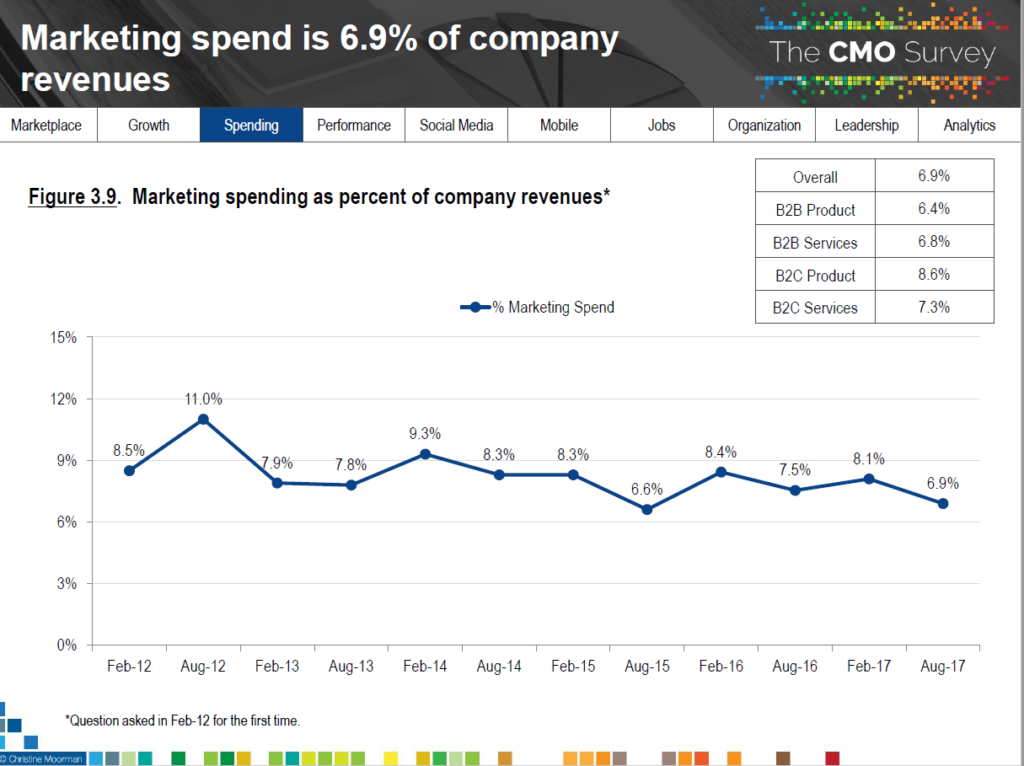During an event I was hosting about the perfect B2B Marketing Plan, a participant asked the following question:
How do I calculate the marketing budget I need?
To kick of the discussion, here is what The CMO Survey told us last year, regarding 2017 marketing budgets in the United States: 6.6% of B2B companies’ revenues are allocated to the marketing budget.

This gives us something to benchmark against. And it’s always useful! But in real life, we’ll not go and knock on our CEO or CFO’s door, and ask for 6.6% of the company revenue to build our marketing plan.
This is what my experience in Marketing Ops has taught me:
Depending on the company in which we operate, one of the following 3 approaches will be available to us. Not all at the same time 🙂 and they may vary from year to year. From one CFO to another. From one CMO to another as well.
Top-down approach budget
In a Top-Down approach, Finance allocates a marketing budget according to criteria we do not control, or even understand. In this case, the term “calculate” seems to me to be usurped. We do not calculate anything, we receive the budget without any margin for negotiation. Instead, we make our best to distribute it in an optimal way, in order to meet the objectives we have set beforehand.
At this stage, this does not mean that this is the budget we need to achieve our objectives… But thanks to the operational marketing plan we will present them later, we will be able to start the discussion.
This approach gave us a framework and saved us time. But it is neither the easiest to manage nor the most appropriate. At best, it proves that Marketing is not yet considered a credible partner: We are not yet considered as a trustful partner, able to determine the budget we need to help achieve our company’s objectives. At worst, our company does not see the link between marketing budget and strategic objectives, otherwise why not allocate us a budget “out of the blue”.
Approach Budget N-1 – Bottom up approach
Very often, we embark on next year’s marketing plan without knowing what will be our budget. This approach therefore consists in using a budget identical to our current one. Best practice will be to work on 2 versions of our operational marketing plan.

A V1, and a V2 minus 10%, in case our finance department needs to make a budget cut. This V2 will also have the merit of identifying the actions that are absolutely essential to achieving our objectives.
And if we are optimistic, we can also add the “nice to have”: what would be nice to add to the plan if we were given an extension.
This approach has the merit of referring to our actuals. We can refer to what has worked, what generated marketing contribution, for example. But the risk is to lock oneself into always doing the same thing, without questioning, while the market does not remain static.
Zero Based Budget – Bottom up Approach
My favorite approach. With the ZBB, we start from scratch. Very large companies have chosen this option (Coca Cola to name just one). With the Zero Based budet, we really CALCULATE our marketing budget according to objectives. Rather than “building an operational marketing plan based on the budget received”.
Many articles limit themselves to recommending the Zero Based Budget to reduce expenses. However, this option gives us the opportunity to do things differently and focus on the essential! Let’s forget what we’ve always done “because we’ve always done it” and think about what will have an impact. Because having more budget often means doing more but not necessarily better.
With ZBB, we focus more on “doing the right things” than “doing things right”.
We align directly with the Strategy, and what we need to support it.
And now, where do we start?
As mentioned above, this step takes place after the strategic marketing objectives have been set, and we we will now start to build our operational marketing plan. We must therefore always keep in mind the objectives to be achieved.
Structural costs
Whatever the approach followed, it is essential to start by identifying our structural costs, i.e. everything we need to do our job: CRM, database, emailing tool, MRM, Marketing automation, reporting and dashboards,…
For a small company, this line is generally empty. Many marketing tools are free and meet basic needs.
As far as large groups are concerned, this amount will represent a significant part of the marketing budget. But again, tools are only necessary if they contributes to acheiving our objectives.
According to Gartner, marketing teams allocated 27% of their budgets to technology in 2017. Gartner predicts that marketers will soon spend more on technology than IT. With the development of digital and data, this part of the budget will only grow in the coming years.
“People” line
I have sometimes allocated part of the marketing budget (1 to 2%, or a certain amount per employee) for the implementation of marketing actions that will not directly serve Marketing contribution increase: marketing kick off, personal development, etc. Once again, let us bring this investment closer to strategic objectives. Imagine that the company’s objective for 2019 is to improve employees retention. Then this budget used to increase the marketing retention will directly align with the company objective.
Finally, the Programs line
In the first 2 approaches, we deducted the structural budget, then the “people” budget from an amount already established. This leaves with the amount available for the operational programmes! In the Zero Based Budget approach, the page is blank and the amount is to be calculated.
Majority of programs are generally related to leads generation or customer engagement. If this is not your case, ask yourself again about your objectives 🙂
It is therefore very useful at this stage to know your sales and marketing performances:
- Contacts/leads channels acquisition,
- Cost of a lead or opportunity,
- Conversion rates,
- Campaign performances by channel,
- Revenues achieved and marketing contribution N-1
- …
Depending on the information you have, you can calculate your budget:
Cost of a lead is 10$. I need 100 leads for 1 opportunity. Opportunity to win conversion rate is 50%. Sales average amount is 1 000$. Sales target is 50 000$. How much budget do I need?
or
N-1 revenues = 500,000$ and business volume was x 3, ie 1,500,000$. Marketing contributed 50% of this volume, ie €750,000, with a marketing budget of 50 000$. How much will I need for a revenue target of 700 000$?
Obviously, as you will have understood, these examples are extremely simple. Nevertheless, they demonstrate – was it necessary – that marketing budget should not come out of the blue. And, if this is your first marketing plan and budget and you don’t have references, call your peers. Ask your friends. Join free conferences. Dare to say that you don’t know and ask for help.
Even better: ask Béautiful Numbers ! 🙂
Béatrice Loriot – + 33 6 81 07 34 41 / + 34 680 907 987 – Bloriot@beautifulnumbers.fr

En tant que DAF Externe et anciennement DAF filiale ayant eu affaire à ces sujets d’élaboration budgétaires (et revisions un à deux fois par an), je suis en plein accord avec les problématiques soulevées et l’approche préconisée. Il y a aussi un facteur très important que l’on pourrait rajouter et qui concerne le respect des délais de restitution des chiffres. La DAF étant “en bout de chaîne” pour reporter, elle a besoin que les différents départements, dont Marketing, remontent ses budgets dans les temps et avec un peu de marge pour analyse et modification le cas échéant. Or j’ai pu constater que c’est parfois ce qui manque, l’aspect chiffré étant repoussé jusqu’au dernier moment, peut-être par manque d’appétence à construire son budget. C’est aussi pourquoi les DAF privilégient parfois l’approche top-down, malheureusement. Bref, il y a pour tous une marge de progression!